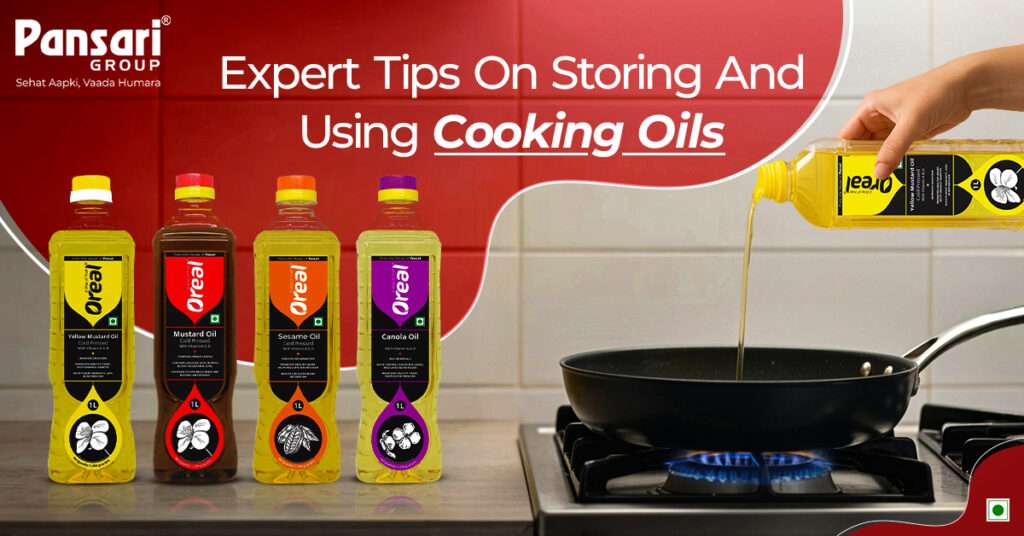While most of us give the utmost importance to choosing the best heart-healthy oil and focus on ingredients and recipes, little thought goes into how we use and store the cooking oil. Mismanagement may lead to improper storage which poses the risk of rancidity, nutrient loss, and while using oil, benefits diminishing due to incorrect application.
The guides allows you to have an edge on every meal masterpiece by learning how to store oil and use it efficiently. If you are looking for the best cooking oil, these tips are timeless.
Learn Your Oil: How You Need Different Oils
Not all oils are created equal. Be it olive, sunflower, mustard or groundnut, each one has its pros and cons.
- Because of their nutrients, cold pressed oils are subjected to faster degradation from light and air
- Some oils with a longer shelf life, like refined oils, do offer the benefit of losing nutritional value.
- When frying, oils with high smoke points such as rice bran or groundnut oil are highly recommended.
- For dressings and light sauteing, sesame and flax seed oils are preferred.
Knowing what type of oil helps to maximize its benefits for heart health and proper usage in the kitchen.
Quick Comparison: Common Cooking Oils at a Glance
Here’s a helpful table comparing popular types of cooking oil, their ideal use, and how to store them:
| OIL TYPE | SMOKE POINT | BEST USE | STORAGE TYPE |
| Mustard oil | 250°C | Indian cooking, pickling | Store in a dark bottle in a cool cabinet |
| Groundnut oil | 230°C | Frying, sauteing | Keep tightly sealed in a pantry |
| Cold pressed olive oil | 160°C | Salad, light sauteing | Store away from light, do not refrigerate |
| Sesame oil | 210°C | Low heat cooking, dressings | Refrigerate after opening; use within 4-5 months |
| Sunflower oil | 255°C | Everyday cooking | Store in original container or a dark glass bottle |
| Flaxseed oil | 107°C | Drizzling, raw use only | Always refrigerate; very sensitive to heat and light |
This table reinforces the importance of choosing and storing your oil wisely. The best way to store cooking oil depends on its smoke point and how sensitive it is to light and air.
Why Storage Matters for Cooking Oils
Even the best cooking oil can turn harmful if stored improperly. Exposure to heat, light, and oxygen causes oils to oxidize and degrade.
Follow these storage practices:
- Keep it cool: Store oils away from your stove or any heat source
- Choose dark bottles: Transfer oils from plastic or clear bottles to dark glass ones
- Tighten lids: Prevent oxidation by sealing bottles tightly after use
- Avoid plastic containers: Use glass or stainless steel to preserve purity
- Know when to refrigerate: Oils like flaxseed and sesame should be refrigerated
Whether you’re using cold-pressed or refined oils, these methods help maintain quality.
Check for Freshness: When to Discard
Even the best cooking oil for heart health has a shelf life. Most oils should be used within 6 months after opening.
Watch for signs of spoilage:
- Sour or unusual smell
- Cloudiness or thickness
- Change in color or taste
If your oil shows any of these signs, it’s time to discard it. Knowing when not to use oil is just as important as knowing how to use cooking oil.
Use It Right: Cooking Tips for Everyday Meals
Using oil correctly adds flavor and helps retain nutrients in food.
Smart cooking tips:
- Don’t overheat: Each oil has a smoke point; stay below it
- Use small amounts: Pour with a spoon instead of directly from the bottle
- Match oil with method: Use olive or mustard for sautéing, groundnut for frying
- Rotate oils: Change your oil every week for variety and better heart health
The best cooking oil only stays the best when it’s used in the right way.
Choose What Fits Your Kitchen
There’s no one-size-fits-all. The best cooking oil for heart health and taste depends on what and how you cook.
Here are some suggestions:
- Mustard Oil: Great for Indian dishes; full of antioxidants
- Groundnut Oil: High smoke point; good for deep frying
- Sunflower Oil: Neutral taste; fits most dishes
- Cold-Pressed Olive Oil: Best for raw use or light sautéing
Choose oils based on your diet, regional cuisine, and storage conditions.
Final Thoughts: Other Tips for Better Nutrition
Selecting the best cooking oil is only the first step in the meal preparation process. Proper storage as well as application largely affects what oils are tasteable and nutritious. Always store oil correctly, use it for its intended function, and don’t ever burn off oil and use it over again. The best cooking oil for heart wellness will not do any good if it is abused.
Use these suggestions to make sure your meals are appetizing, nutritious, and safe.

